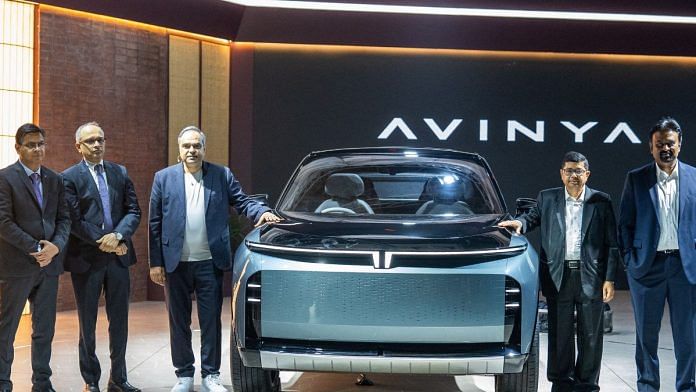It was kind of telling that, after a morning filled with launches of electric cars, the biggest cheers from the audience were for the relaunch of Tata’s iconic Sierra SUV. The diesel car will have a petrol variant too. At least initially, when it goes on sale later this year.
The 2025 Bharat Mobility Global Expo, earlier known as the Auto Expo, kicked off with a clear focus on electric vehicles. From the Maruti Suzuki eVitara to the scissor-doored MG Cyberster and the first made-in-India BMW X1 (long-wheelbase), everything was about EVs. Something that Prime Minister Narendra Modi highlighted in his inauguration speech.
Even Tata Motors highlighted its AvinyaX electric concept, signalling its entry into the luxury segment. Mahindra showcased its new electrics while Vietnamese manufacturer Vinfast announced its entry into India by displaying its new VF6 and VF7 electric SUVs.
As capable as these EVs are, there are several electric two-wheelers to watch out for at the Bharat Mobility Global Expo, which is on till 22 January. These include first-time participants Ather and Ola, with the latter even showcasing its new Roadster motorcycle.
India’s EV wave
Carmakers are cautious despite all the hype around EVs. Electric vehicles, after all, constitute just over two per cent of the overall Indian car market as of 2024.
Toshihiro Suzuki, Chairman of the Suzuki Motor Corporation, interacted with the media just a day before the Expo, on 16 January. And he said that, for electric vehicles to truly take off, batteries must be fitted into smaller cars. And this is even though the Japanese carmaker showcased its new eVitara SUV, which officially launches sometime in the middle of the year.
Suzuki’s sentiment was echoed by Shailesh Chandra, the Managing Director of Tata Motors Passenger Cars. The Indian automobile giant, after all, has sold 200,000 electric vehicles since it entered the space. Moreover, Tata had a 62 per cent share in India’s EV market in 2024 although MG Windsor has been India’s best-selling EV for the last few months.
“Most of the EVs that are being launched right now are coming in the mid-segment with ranges in excess of 300 kilometres. For the electric vehicle market to start growing faster, we need more vehicles with smaller batteries and ranges under 300 kilometres,” Chandra told the press. According to Suzuki, carbon reduction must be looked at holistically. “Maruti-Suzuki is committed towards investments in CNG, Biogas, Flex-Fuel and increasingly Hydrogen vehicles beyond just electrics.”
Also Read: Mahindra Thar Roxx beats Maruti Dzire at ICOTY 2025 in closest result in award’s history
Fixing charging ecosystem
Every automobile manufacturer at the expo spoke about how they were building the charging ecosystem. They also emphasised new ‘all-in-one’ smartphone applications, which allow EV users to plan their routes. I have been driving a BMW iX50 for three months now and drove a Hyundai IONIQ5 for eight months before that. So I know from personal experience that, for electric vehicle ownership to make sense, home charging is a must.
Despite living in rented accommodation, I have access to an 11kW wall box, which is connected to my main metre. As a result, I don’t need to worry about running out of charge. Unfortunately, across Mumbai, Gurugram, Noida, Pune, Bengaluru, and Hyderabad, which have large car markets, apartment owners face severe problems in installing private chargers.
Online forums like Reddit are filled with disputes between owners, resident welfare associations, and electricity boards over charger installation. In some societies in Gurugram and Noida, RWAs have installed their own chargers but charge commercial electricity rates between Rs 25-30 a unit. For the record, I pay between Rs 8-10, including all tariffs per unit, to charge my cars.
Paying more is acceptable for higher-speed DC fast chargers. You’re bound to pay a premium if you’re saving time. But installing such chargers, according to a charging point operator I spoke to, is an expensive business. And it “needs a high throughput – that is constant usage,” he told me. This is not something carmakers can solve. It is a problem governments at every level must solve.
State electricity regulations might need modifications, and municipal governments might need to change their by-laws. In Mumbai, for instance, one cannot install an EV charger if a petrol or diesel vehicle is parked nearby. Additionally, some rules prevent Internal Combustion Engine (ICE) vehicles from parking in designated EV spots. A problem in cities with a parking space crunch.
This is the single biggest hurdle in the way of electric vehicle adoption in India. People don’t buy electric cars for altruistic reasons, like reducing pollution from tailpipes. They buy them because in many cases, they offer genuine convenience. Traffic police in Delhi, for one, doesn’t touch cars with green numberplates, especially during the implementation of anti-pollution measures such as the Graded Response Action Plan (GRAP). And EV users pay a fifth of what it takes to run a petrol or diesel vehicle.
So, while the Expo was truly electrifying and 2025 will see a lot of new electric cars, I’m still hesitant to declare India’s EV transition a success.
@kushanmitra is an automotive journalist based in New Delhi. Views are personal.
(Edited by Zoya Bhatti)






